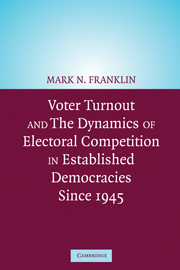Book contents
- Frontmatter
- Contents
- Figures
- Tables
- Preface
- The Authors
- Introduction
- 1 Confronting the Puzzles of Voter Turnout
- 2 A New Approach to the Calculus of Voting
- 3 The Role of Generational Replacement in Turnout Change
- 4 Rational Responses to Electoral Competition
- 5 Explaining Turnout Change in Twenty-Two Countries
- 6 The Character of Elections and the Individual Citizen
- 7 Understanding Turnout Decline
- 8 The Turnout Puzzles Revisited
- APPENDICES
- Bibliography
- Author Index
- Subject Index
Introduction
Published online by Cambridge University Press: 08 February 2010
- Frontmatter
- Contents
- Figures
- Tables
- Preface
- The Authors
- Introduction
- 1 Confronting the Puzzles of Voter Turnout
- 2 A New Approach to the Calculus of Voting
- 3 The Role of Generational Replacement in Turnout Change
- 4 Rational Responses to Electoral Competition
- 5 Explaining Turnout Change in Twenty-Two Countries
- 6 The Character of Elections and the Individual Citizen
- 7 Understanding Turnout Decline
- 8 The Turnout Puzzles Revisited
- APPENDICES
- Bibliography
- Author Index
- Subject Index
Summary
Voter turnout regularly makes news. Seemingly, whenever an election is held, the question comes up: How many people voted? Sometimes the turnout is unexpectedly high. Commentators were amazed at how many people stood for hours in the hot African sun waiting to vote in South Africa's first truly free and universal election. But it is rare to see stories about higher than expected turnout. More often we see stories that express concern at the fact that turnout is lower than expected – so much more often, indeed, that one might be forgiven for supposing that low or declining turnout was ubiquitous in contemporary democratic elections. One prosaic reason for this is the newsworthiness of turnout decline. Stable turnout is not news. Moderately increased turnout is not news. Low or declining turnout is newsworthy. So commentators draw attention to the level of turnout mainly when it is down. How many people are aware that turnout was higher at the American presidential election of November 2000 than at the previous presidential election, in 1996? Of course, the level of turnout in the more recent of those elections was overshadowed by its other, more newsworthy, features – butterfly ballots and such. But the lack of press attention given to increased turnout, when it occurs, is one reason why we have this general perception that turnout everywhere is in decline. What is true is that, whenever turnout is down, the decline makes news.
- Type
- Chapter
- Information
- Voter Turnout and the Dynamics of Electoral Competition in Established Democracies since 1945 , pp. 1 - 8Publisher: Cambridge University PressPrint publication year: 2004



